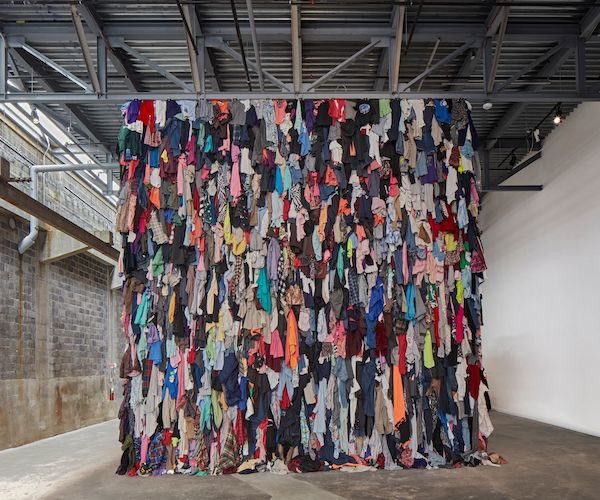Visual Arts Review: Revival — Materials and Monumental Forms
By Chloe Pingeon
This exhibition is impressive in drawing connections between material goods and labor, creating beauty out of unconventional forms.
Revival: Materials and Monumental Forms at the ICA Watershed, Boston, through September 4.

Joe Wardwell, “Gotta Go to Work, Gotta Go to Work, Gotta Get a Job,” 2022. Acrylic on wall, dimensions variable. Installation view at Materials and Monumental Forms, the Institute of Contemporary Art/Boston, 2022. Photo: Charles Mayer.
I arrived at the ICA Watershed by boat. It’s a sunny afternoon, and the choppy ride across Boston Harbor feels like a sharp departure from the clean and polished exterior of the main ICA location that I am leaving in the distance. The boat is open, and surrounded by wind, sea spray, and the approaching docks of East Boston. I am leaving the sense of abstract space created by a gallery and making a connection to the physical world as I take the boat ride to the East Boston Watershed. (It is a distance by car or public transport from the ICA’s Seaport location, so the boat ride is a welcome convenience.). Still, moving through Boston harbor being deposited parallel to the fishing boats of East Boston serves as part of the aesthetic experience of the ICA Watershed, a connection to the natural world and the area’s vibrant communities.
Revival: Materials and Monumental Forms taps into themes of production and dependency. Nothing is made out of thin air, no labor is performed by disembodied hands. The material used to make objects is reused, layered and recycled. Along the way, ownership and accreditation become increasingly difficult to determine. The watershed show takes a critical look at these layers of production. The pieces here are made up of repurposed material, ranging from salvaged car taillights to protest song lyrics. The show’s concept is that the artists are giving credit to undervalued labor by creating new forms out of old. In the past, the East Boston Watershed was a copper pipe and sheet metal manufacturing plant. In 2018 the building was repurposed for the ICA, so the structure itself dramatizes the idea of repurposing material and acknowledging the work of earlier laborers.
Upon entering the building you see a sentence inscribed on a large white placard: “The ICA Watershed was born out of our commitment to connect contemporary art and community on both sides of Boston Harbor.” Behind the sign, the building’s raw stone walls and cement floor are visible. The group exhibition on view features six international artists who have created the same number of large scale installations. Your initial visual perception is made all the more powerful because the art is surrounded by vast negative space of the structure. From the entryway, only the first two installations are visible. There is a glimmering black wall of five collages mounted on a white frame by Ebony G. Patterson. At first glance, the piece depicts a garden in vivid color, flourishing in wild abundance.But a closer look reveals the figures of three women overwhelmed by the growth. To create something you must destroy something, seems to be the ambivalent message here. The figures are swallowed up by the gardens containing the fruit of their labor. The collages nod towards the agricultural exploitation of colonialism; those who cultivate the earth become lost and then forgotten once the harvest is in. Just beyond Patterson’s collages shimmers El Anastui’s “Area B,” an aluminum and copper sculpture whose wave-like form generates an illusion of fluidity, of liquid movement, despite it’s mostly metallic make-up. The fluidness of the installation is symbolic of the changeability of maps, ownership, and space.

Karyn Olivier, Fortified, 2018–2022. Bricks, used clothing and steel, approximately 144 × 240 × 30 inches (365.8 × 609.6 × 76.2 cm). Courtesy the artist and Tanya Bonakdar Gallery, New York/Los Angeles. Installation view, Revival: Materials and Monumental Forms, the Institute of Contemporary Art/Boston, 2022. Photo by Charles Mayer.
The rest of the exhibition snakes onwards in a maze-like formation. The echoey watershed space is constant as I weave my way around temporary walls and take in the towering installations. Madeline Hollander uses junkyard cars to create an almost lyrical display of flickering headlights and abandoned tailgates. Ibrahim Mahama’s wall of crates and abandoned suitcases is next to Kathryn Oliver’s wall of abandoned clothing in which textiles take the place of traditional mortar. Finally, there is Joe Wardwall’s site specific commission, Gotta Go To Work, Gotta go to Work, Gotta Get a Job. The work, outlined against a glass wall through which the harbor and East Boston horizon is visible, layers protest song lyrics and personal reflections from the East Boston community against a view of East Boston. It is framed by a metal structure whose lines parallel the architecture of the watershed.
This exhibition is impressive in drawing connections between material goods and labor, creating beauty out of unconventional forms. But, in contrast to other recent ICA exhibitions, such as the sweeping survey of the life and work of photographer Deana Lawson, the message is disappointingly transparent. Six artists were tasked with creating works that treated the products of labor as abstractions, and they succeeded. The social concerns of these rawly physical but beautiful works are their obvious start and end points. Ironically, the ICA watershed itself, a monumental example of the transformation and renewal of material and the displacement of labor, says as much, if not more, than the show about this theme.
Chloe Pingeon recently graduated from Boston College, where she studied film and journalism. She has written regularly for the features and arts section of Boston College’s Independent Student Newspaper The Heights, and has also written for the culture section of Lithium Magazine. She is currently a creative development intern at Foundation Films.
